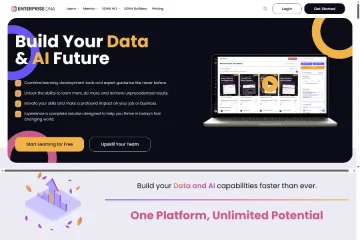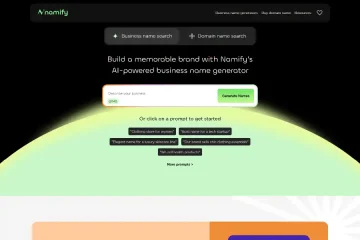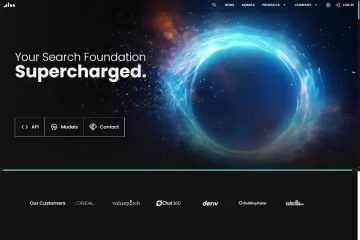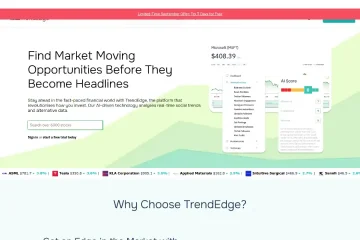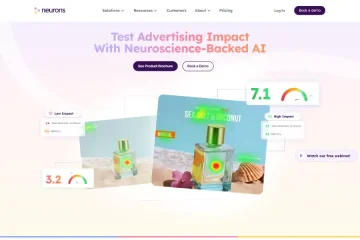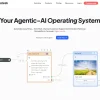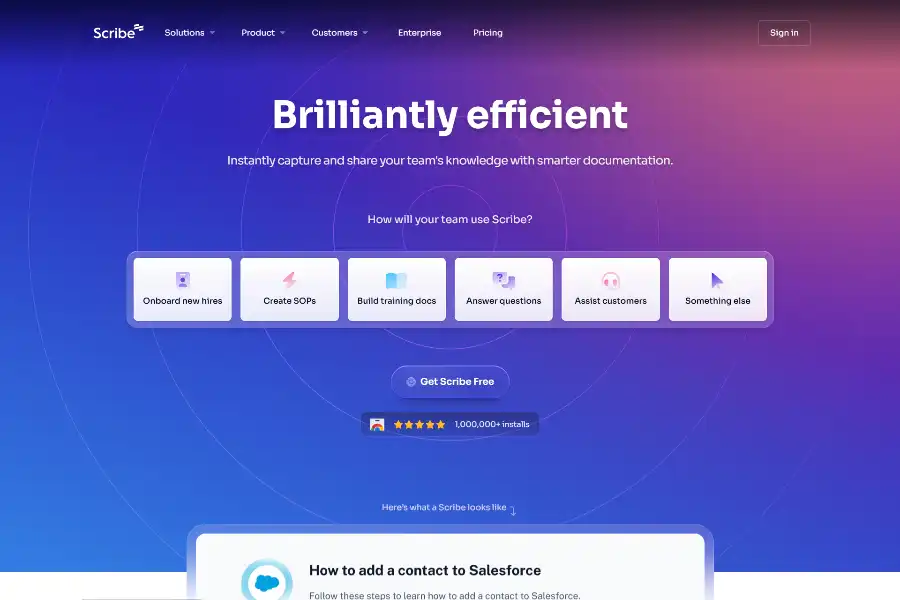
Scribe AI: The Complete Analyst & Marketing Deep-Dive
Introduction – Why Scribe Matters in 2025
Scribe has quietly become one of the fastest-growing productivity applications on the planet. With more than one million Chrome-store installs, a 4.8/5 rating on every major software-review site, and a public claim that 94 % of the Fortune 500 already rely on it, Scribe is no longer an early-stage curiosity—it is a category-defining standard for “process documentation at machine speed.” This report unpacks the technology, business impact, competitive moat, and future roadmap of Scribe so that technology leaders, marketing strategists, and change-management consultants can decide where, when, and how to deploy it at scale.
Core Product Overview
Scribe is a browser extension and desktop recorder that transforms any workflow—web or native—into a self-contained, branded, step-by-step visual guide in roughly the same time it takes to perform the task once. The output is a shareable URL, an embeddable iframe, or a PDF that can live inside wikis, LMSs, ticketing systems, or customer-facing knowledge bases. Unlike legacy screen-recording tools that stop at annotated screenshots, Scribe auto-generates plain-language instructions, redacts sensitive data, and updates itself when the underlying application UI changes.
Technical Architecture & AI Engine
Scribe’s stack can be decomposed into three layers:
Capture Layer
A lightweight JavaScript agent injected into the browser (Chrome, Edge, Safari) or a native desktop shim for Windows / macOS monitors DOM mutations, keyboard events, mouse movements, and application state transitions. These events are serialized into a time-stamped stream that preserves causality (e.g., “clicked ‘Next’ after entering password”).
Intelligence Layer
The stream is fed into a fine-tuned multimodal transformer model that performs:
- Intent recognition – maps low-level events to human-readable actions (“Click ‘Submit Expense Report’ button”).
- Layout understanding – uses computer vision to crop and annotate screenshots only around the relevant viewport region.
- Policy compliance – applies regex and named-entity recognition to detect and redact PII, PHI, or other configurable data classes.
The model is continuously retrained on anonymized opt-in data, which explains why accuracy and language localization improve monthly without new client-side releases.
Distribution Layer
Guides are rendered server-side as responsive HTML5, then cached on a global CDN. An oEmbed endpoint and a Slack / Teams bot allow zero-friction sharing; a REST API lets enterprises inject guides into in-house applications at runtime.
Feature Deep Dive
One-Click Capture
The user simply presses “Start Capture,” performs the workflow, and presses “Stop.” Scribe automatically stitches screenshots, adds callouts, and writes concise instructions (average processing time: 12 s for a 15-step flow).
Auto-Generated SOPs & Training Manuals
Beyond single guides, Scribe can compile dozens of discrete workflows into hierarchical standard-operating-procedure documents complete with table of contents, revision history, and role-based permissions.
Sensitive Data Redaction
SOC 2 Type II–compliant algorithms blur or substitute email addresses, API keys, and account numbers; admins can whitelist safe regions if desired.
Custom Branding & White-Label
Enterprise customers upload logos, fonts, and hex codes so that external clients never realize the guide was produced by a third-party tool.
Analytics & Continuous Improvement
An analytics dashboard surfaces drop-off points, average completion time, and search queries. Product teams can A/B-test two versions of the same guide and see which yields higher task-completion rates.
Primary Use Cases & Industry Snapshots
Technology Enablement
- SaaS onboarding: A Series-C fintech slashed new-hire ramp time by 50 % by replacing 40-page PDFs with 120 living Scribes.
- Release management: DevOps teams embed Scribes into Jira tickets so QA engineers reproduce bugs exactly as support saw them.
Healthcare & Life Sciences
- HIPAA-compliant playbooks for Epic EMR workflows reduced help-desk tickets by 35 % at a 12-hospital system.
- Clinical-trial coordinators document adverse-event reporting steps once and localize them into six languages without extra regulatory overhead.
Financial Services
- A top-5 U.S. bank created 700+ guides for mortgage origination after a core-system migration, cutting training time from eight weeks to three.
- Compliance officers auto-redact customer SSNs and wire-transfer details before external auditors review documentation.
Professional Services
- Management-consulting teams capture knowledge during short-term engagements and export branded PDFs for handoff, preserving billable IP without extra write-ups.
Voice of the Customer
Aggregate G2, Capterra, and Chrome-store data (n ≈ 7 800 reviews) reveal four recurring themes:
Ease of Use: 97 % mention “ridiculously simple” setup.
Time Savings: Median reported saving is 15× faster documentation (low: 5×, high: 40×).
Support Quality: Enterprise customers praise 24-hour SLA and dedicated CSMs.
Feature Gaps: Requests for mobile-app capture and deeper LMS-grade quiz integration dominate the roadmap voting portal.
Competitive Landscape
Traditional rivals—Snagit, Loom, WalkMe, and SharePoint—excel in either screen capture OR interactive walkthroughs, rarely both. Scribe’s differentiation lies in the intersection: automatic text generation plus enterprise-grade governance. While WalkMe offers richer in-app nudges, its per-seat pricing is 5–7× higher. Loom provides async video but lacks editable step lists. Scribe’s freemium entry point and flat-rate Pro tiers undercut both.
Pricing & Packaging Strategy
- Free: Unlimited public guides, 5 MB storage, community support.
- Pro: $12 user / month (annual) adds private sharing, redaction, custom branding.
- Enterprise: Volume discounts starting at 50 seats, SSO/SAML, SOC 2 audit letters, data residency options.
- OEM / API: Usage-based pricing for ISVs embedding Scribe inside their own products.
The packaging aligns with the classic land-and-expand motion: individual champions adopt free, then compliance or HR mandates an org-wide rollout.
Security & Compliance
Scribe is SOC 2 Type II certified, HIPAA-ready (signed BAA), and offers GDPR/CCPA data-processing addendums. All traffic is TLS 1.3 in transit; AES-256 at rest. Enterprise tenants can choose AWS US-East-1, EU-Central-1, or AP-Southeast-1 regions. A forthcoming FedRAMP-Moderate authorization is in scoping for late 2025.
Integration Ecosystem
Out-of-the-box integrations include Confluence, Notion, SharePoint, Slack, Microsoft Teams, Zendesk, ServiceNow, and Docebo. A Zapier connector plus REST and GraphQL APIs enable low-code orchestrations—for example, auto-posting a Scribe to a Jira comment when a “how-to” label is applied.
Future Roadmap & Analyst Outlook
Public statements and job postings suggest three vectors:
- Mobile Capture: Beta for iOS Safari extension targeting field-service workflows.
- Generative AI 2.0: A “ScribeGPT” chatbot that answers contextual questions inside the guide itself.
- Vertical Solutions: Pre-built template libraries for SOC 2 audits, ISO 27001 controls, and PCI-DSS evidence gathering.
Assuming execution velocity remains constant, Scribe is positioned to become the de-facto system-of-record for operational knowledge inside mid-market and enterprise firms, much the way Figma displaced Visio for design assets.
Risks & Mitigations
Model Drift: If UI patterns change faster than retraining cycles, guide accuracy degrades. Mitigation: Scribe plans to ship client-side “self-heal” heuristics that flag outdated callouts for re-capture.
Privacy Concerns: Redaction is probabilistic; edge-case leaks could erode trust. Mitigation: on-prem OCR gateway for ultra-sensitive environments is on the 2026 roadmap.
Competitive Response: Microsoft, Google, or Atlassian could bundle similar AI documentation into their suites. Mitigation: Scribe’s API-first architecture and enterprise SLAs create switching costs higher than a native feature checkbox.
Conclusion – Strategic Takeaways
For CIOs seeking to accelerate digital adoption without ballooning support headcount, Scribe offers an ROI-positive lever that pays for itself within the first month of enterprise rollout. For marketing leaders, the product’s viral sharing loop and brandable outputs turn every customer success story into a micro-promotional asset. For L&D teams, the shift from static PDFs to living, searchable guides aligns with Gen-Z expectations of just-in-time learning.
In short, Scribe has moved beyond the “cool Chrome extension” phase into critical infrastructure for knowledge-driven organizations. The combination of best-in-class AI, enterprise governance, and transparent pricing creates a rare moat in an otherwise crowded productivity market.

